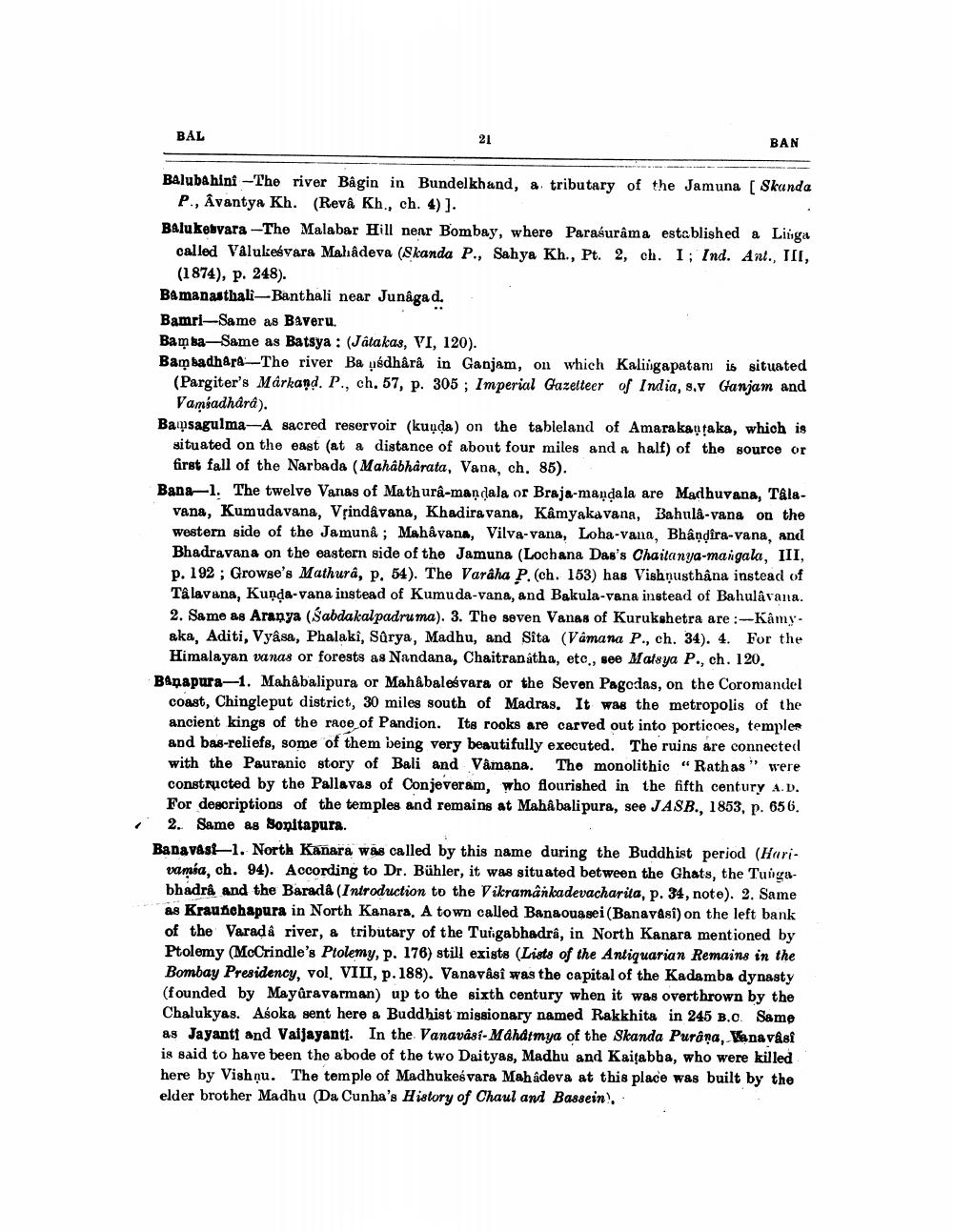________________
BAL
BAN
Balubahini -The river Bâgin in Bundelkhand, & tributary of the Jamuna (Skanda
P., Âvantya Kh. (Revâ Kh., ch. 4)). Balu kebyara -The Malabar Hill nenr Bombay, where Parasurama established a Linga
called Valukeavara Mahadeva (Skanda P., Sahya Kh., Pt. 2, ch. I; Ind. Ant., TII,
(1874), p. 248). BAmanasthali-Banthali near Junagad. Bamri-Same as Baveru. Bamba-Same as Batsya : (Jatakas, VI, 120). Bam badhara -The river Ba védhårå in Ganjam, on which Kalingapatani is situated
(Pargiter's Markand. P., ch. 57, p. 305 ; Imperial Gazetteer of India, s.v Ganjam and
Vamsadhárå). Bamsagulma-A sacred reservoir (kuqda) on the tableland of Amara kanțaka, which is
situated on the east (at a distance of about four miles and a half) of the source or
first fall of the Narbada (Mahabharata, Vana, ch, 85). Bana-1. The twelve Vanas of Mathurâ-mandala or Braja-mandala are Madhuvana, Tala
vana, Kumudavana, Vrindavana, Khadiravana, Kâmyaka vana, Bahulå-vana on the western side of the Jamuna ; Mahayana, Vilva-vana, Loha-vana, Bhândira-vana, and Bhadravana on the eastern side of the Jamuna (Lochana Das's Chaitanya-mangala, III, p. 192 ; Growse's Mathurâ, p. 54). The Varaha P. (ch. 153) has Vishmusthâna instead of Talavana, Kunda-vana instead of Kumuda-vana, and Bakula-vana instead of Bahulavana. 2. Same as Aranya (sabdakal padruma). 3. The seven Vanas of Kurukshetra are :--Kâmy. aka, Aditi, Vyâsa, Phalakî Sûrya, Madhu, and Sita (Vamana P., ch. 34). 4. For the
Himalayan vanas or forests as Nandana, Chaitranátha, etc., see Matsya P., ch. 120. BAnapura-1. Mahabalipura or Mahâbalesvara or the Seven Pagodas, on the Coromandel
coast, Chingleput district, 30 miles south of Madras. It was the metropolis of the ancient kings of the race of Pandion. Its rooks are carved out into porticoes, templer and bas-reliefs, some of them being very beautifully executed. The ruins are connected with the Pauranic story of Bali and Vamana. The monolithic "Rathas" were constructed by the Pallavas of Conjeveram, who flourished in the fifth century A.D. For descriptions of the temples and remains at MahAbalipura, see JASB., 1853, p. 656.
2. Same as Sonitapura. Banavast1. North Kanara was called by this name during the Buddhist period (Hari
vamia, ch. 94). According to Dr. Bühler, it was situated between the Ghats, the Tungabhadra and the BaradA (Introduction to the Vikramankadevacharita, p. 34, note). 2. Same as Kraunehapura in North Kanara, A town called Banaouasei (Banavasi) on the left bank of the Varadâ river, & tributary of the Tuigabhadrâ, in North Kanara mentioned by Ptolemy (McCrindle's Ptolemy, p. 176) still exists (Lists of the Antiquarian Remains in the Bombay Presidency, vol. VIII, p. 188). Vanavâsî was the capital of the Kadamba dynasty (founded by Mayâravarman) up to the sixth century when it was overthrown by the Chalukyas. Asoka sent here a Buddhist missionary named Rakkhita in 245 B.C. Same as Jayanti and Vaijayanti. In the Vanavasi-Mahatmya of the Skanda Purana, Kanavasi is said to have been the abode of the two Daityas, Madhu and Kaitabba, who were killed here by Vishnu. The temple of Madhukeśvara Mahadeva at this place was built by the elder brother Madhu (Da Cunha's History of Chaul and Bassein.




